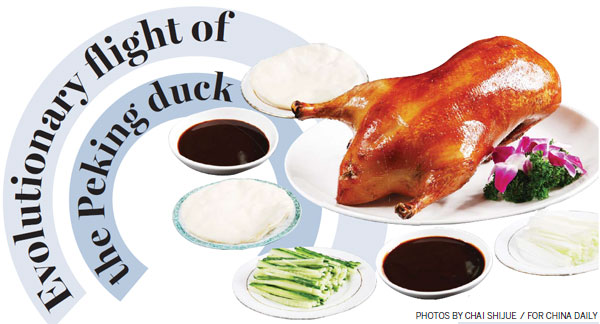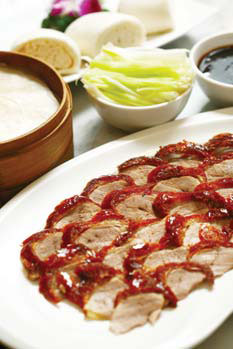Evolutionary flight of the Peking duck
Updated: 2016-09-02 08:39
By Pauline D Loh(China Daily Europe)
|
|||||||||
Editor's note: To understand China, sit down to eat. Food is the indestructible bond that holds the whole social fabric together and it is also one of the last strong visages of community and culture.
Every time I visited my mother in Hong Kong when we were all much younger, she would feed me my favorite comfort foods - a steaming bowl of slippery rice noodles with a roast goose drumstick, and Peking duck.
It was the early 1970s, and times were still hard. She didn't have much money to spare, but she often treated me and my two brothers to Peking duck whenever she could afford it.

Once, we had made a reservation at an old-style Tsimshatsui northern Chinese restaurant when the weather bureau suddenly hoisted typhoon signal No 3.
The meal was worth risking stormy weather.
First, the duck skin would be quickly but artfully sliced by a chef tableside in a performance that had us mesmerized. When the platter was finally placed in front of us, we would almost worshipfully cradle the gleaming, red crisp skin in wheat wrappers after smearing them with sweet bean paste and placing some julienned radishes and scallions alongside.
The little packets would be finished in two bites.
The chef would take the now skinless duck back into the kitchen, have the meat shredded and fried with seasonal vegetables, and the stripped carcass went into a pot to make soup, always with Chinese cabbage.
My mother said it was called one duck served three ways. That one order alone was always enough to feed the four of us.
Peking duck remains one of my favorite treats, if it is done properly.

On my first visit to Beijing in the early 1980s as a journalist, I was hosted for lunch at Quanjude, the restaurant whose name was, and still remains, synonymous with Peking duck.
It was a huge, all-duck banquet. As usual, the ritual started with a chestnut-brown, taut shiny bird. The chef proceeded to slice the skin into more than 100 pieces. The wraps were freshly made, and all the colorful condiments were laid out on a battery of saucers.
The remaining space on the table was filled with platters of duck feet drenched in bright-yellow mustard, chilled duck liver and gizzards, spicy duck tongues, stewed wing tips and intestines. Everything but the beak was served.
It was truly impressive, but even then. I found the bird a tad oily with its thick layer of fat under the skin.
My Beijing-bred husband later told me that fat was a luxury in the first hungry years after the "cultural revolution" (1966-76), so Beijing folks wanted their birds this way. You had to have your lips shiny with oil to show you'd eaten such a sumptuous meal. I can accept that.
It also explained why Beijingers like dipping the skin into granulated sugar. They say crunchy sugar makes the spongy fat even more palatable.
Fast-forward to the 21st century, and Quanjude has stayed in a time warp, with the only change coming in 2008 when it had to cater to the athletes at the Olympic Village and gave up using its fruitwood-fired ovens.
There are still busloads of tourists from all over China who fill up the restaurant's many branches, usually straight after they've taken the mandatory group shots at Tian'anmen Square. They still want their duck-fat lip gloss.
With the Beijing culinary scene evolving almost overnight these days, other chefs have seen that change can be more lucrative, especially with increasing numbers of health-conscious visitors arriving from abroad.
The first Peking duck revolution was led by a chef named Da Dong, who had headed one of Quanjude's branches on the Third Ring Road and later bought the shop. He named it after himself and proceeded to imprint his personal style.
Dong is a classically trained chef of Lu cuisine, a direct disciple of the last grandmaster. He could have followed the beaten path, but fortunately he did not.
He is one of the forerunners of good Chinese food beautifully presented in this city, and he makes the dining experience almost poetic with an ambiance aided by Chinese paintings and calligraphy. Now, his restaurants command some of the highest priced menus for an exclusive Peking duck meal.
His duck is two-thirds the size of the old-style birds and just a little more expensive. But the rest of the menu offers luxurious samplings of the chef's other talents, including his signature beche-de-mer braised in fragrant scallion oil.
Between Dong's nouveau duck and Quanjude's hardcore original, there is a growing number of chefs who have made the Peking duck a menu staple.
In international hotels, regional cuisines have gradually blended into the menu to offer diners more choices and an instant bite of China. You no longer have to go to specialty outlets to enjoy Beijing's signature dish.
As with every cuisine, Peking duck, too, is finally evolving to suit the modern palate, sometimes with creative twists on the old standard.
There are now even attempts to sell the fast-food generation Peking duck burgers, an experiment by our old friend Da Dong.
Changes are inevitable, but half the fun of eating Peking duck is in the ritual, don't you think?
paulined@chinadaily.com.cn
Peking duck with a popping twist
The Xihe Yayuan Peking duck restaurants are among those that have chosen the middle ground. They cater to those who want a duck feast without completely turning out their pockets.
Their menus offer a blend of styles and their restaurants are now spread all over Beijing's central business district. Most of all, they have developed an excellent reputation for honest food.
Recently, Xihe's ducks started migrating outside of Beijing. The company has opened an outlet in Tianjin at The St. Regis Hotel, with more to follow.
Xihe's Peking ducks are lean, but still plump enough that the fat under the skin renders and crisps the main attraction. The skin is served twice, one platter being pure crackling, followed by another plate of skin with some meat under it.
I like this idea, because you really get to taste roast duck, and not just the top layer.
Delicate slivers of cucumber, cherry radish and Chinese leeks provide tactile contrasts and flavors.
But it is the condiments that are thoughtful. There is the standard Beijing bean paste thinned with a little honey. Another Beijing favorite, yellow mustard, is diluted with a Japanese apple cider vinegar that gives it a fruity fragrance.
The surprise is in a little platter of white crystals - sweet popping candy. We were instructed to dip the slices of skin right into the crystals and, as we chewed, it seemed as if the duck was dancing in our mouths.
It was a novelty, of course, and made the meal a talking point, but it is one of the more pleasant and memorable changes in the long journey of evolution of Beijing's favorite duck.
(China Daily European Weekly 09/02/2016 page18)
Today's Top News
Mexico contradicts Trump on paying for border wall
British born Chinese face cultural challenge
UK house prices rise after Brexit hit
Brazil's Senate removes President Rousseff from office
EU to push for six priorities at G20 summit
Merkel opens Germany's 17th Confucius Institute
France's outgoing minister vows to 'transform' France
EU orders Apple to pay 13 bln euros tax to Ireland
Hot Topics
Lunar probe , China growth forecasts, Emission rules get tougher, China seen through 'colored lens', International board,
Editor's Picks

|

|

|

|

|

|







